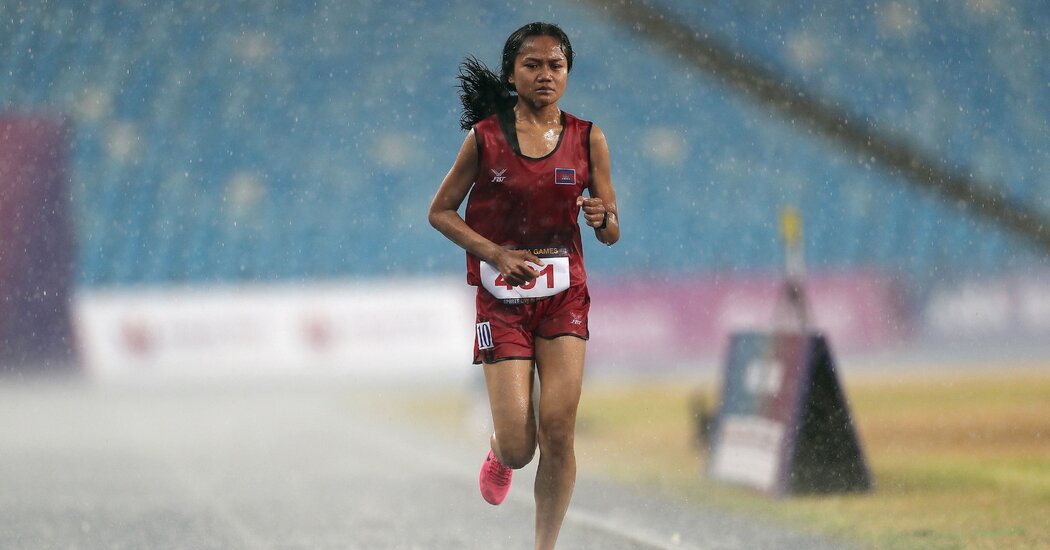Runner number 401 was dead tired and suffering from low blood pressure. She was also last by a wide margin in the 5,000 meters and plodding alone, through a raucous rainstorm, around the track of a near-empty stadium.
Bou Samnang, 20, finished the race anyway.
Her rain-soaked performance at the Southeast Asian Games — this year’s edition was hosted this month by her home country, Cambodia — would have been a footnote in a tournament that is unknown to most sporting fans outside the region. But when video of it circulated widely on social media, she became an unlikely national celebrity.
“I knew that I would not win, but I told myself that I should not stop,” she said in an interview.
As she struggled on, it helped that a small group of supporters were applauding furiously, she added, and that she felt a duty to finish because she was representing her country.
After she crossed the finish line, she acknowledged the fans, started to cry and buried her face in a Cambodian flag.

Ms. Bou Samnang, who graduated from high school last year, did not expect to attract international attention when she arrived on May 8 for the 5,000-meter final in Phnom Penh, the capital and her hometown. She was grateful just to be competing.
A few weeks earlier, Ms. Bou Samnang had suffered from a particularly bad bout of low blood pressure, a result of her chronic anemia, while she was training in the southwestern Chinese city of Kunming. A doctor told her to stop running for a while, and her coach, Kieng Samorn, did not insist otherwise.
“She has a health problem,” Mr. Kieng Samorn said. “We can’t force her.”
But Ms. Bou Samnang said she was eager to run at the Southeast Asian Games, her first international competition, and her coach did not stand in her way.
In the 5,000-meter women’s final, held in a lightly attended 60,000-seat stadium, Ms. Bou Samnang gathered at the starting line alongside some of the region’s best runners. The eventual winner, Nguyen Thi Oanh of Vietnam, is an Olympian who had won multiple golds at previous Southeast Asian Games.
After the starting gun sounded and the runners fell into formation, Ms. Bou Samnang took a position toward the back of the pack. Within a minute or so, she had fallen so far behind that she was not visible in much of the television coverage.
But she kept going, even as Ms. Oanh and other runners finished, the skies opened up, and some fans lost interest.
Ms. Bou Samnang would finish in 22 minutes and 54 seconds — nearly six minutes behind Ms. Oanh of Vietnam and about 90 seconds behind a compatriot, Run Romdul. By then the stadium floodlights were out, water was pooling on the track, and her pink shoes and red uniform were completely soaked through.
Her performance recalled other runners who persevered, including a few who famously won track events after falling. One is Sifan Hassan of the Netherlands, who did so in the 1,500-meter event at the Tokyo Olympics two years ago.
Runners don’t tend to win much praise if they lose by a wide margin. One exception is in long-distance events, where it’s common to celebrate the last finisher, said Steve Brammar, the secretary general of the Trail Runners Association of Hong Kong. An ultramarathon trail race that he directs there has an “Ultimate Finisher” trophy for just that purpose.
Ms. Bou Samnang’s “perseverance was inspiring and really seems to have warmed hearts and captured imaginations,” Mr. Brammar said in an email.
After finishing last in the 5,000-meter race this month, Ms. Bou Samnang’s health prevented her running the 1,500-meter event, as planned, her coach said. But after video of her determined performance circulated online, she received public praise from Cambodia’s king and a $10,000 bonus from Prime Minister Hun Sen and his wife, equivalent to several years of an average Cambodian’s earnings.
Ms. Bou Samnang, whose father died in 2018, is the third of four children. She said she would use the bonus to study law at a Cambodian university, and that she planned to keep running competitively.
Her mother, Mai Met, said that she cried after hearing that her daughter had finished last in the 5,000-meter race. But that sadness was tempered by the outpouring of public support that came later.
“I am delighted,” said Ms. Mai Met, 44, who has long supported the family by working in garment factories.
Her determined finish illustrated an “ideal of sport,” said Edgar K. Tham, a sports psychologist in Singapore who works with athletes around Southeast Asia.
He said the attention Ms. Bou Samnang has received is notable in part because Cambodian athletes tend to fare better at combat sports than track events in regional competitions.
But the example she set, he added, will resonate far beyond Southeast Asia.
“That’s what life’s about: moving forward and using failures as lessons to bounce back,” he said. “If you take it in this spirit, it’s something inspirational.”
Mike Ives is a general assignment reporter. @mikeives
Source: Read Full Article


